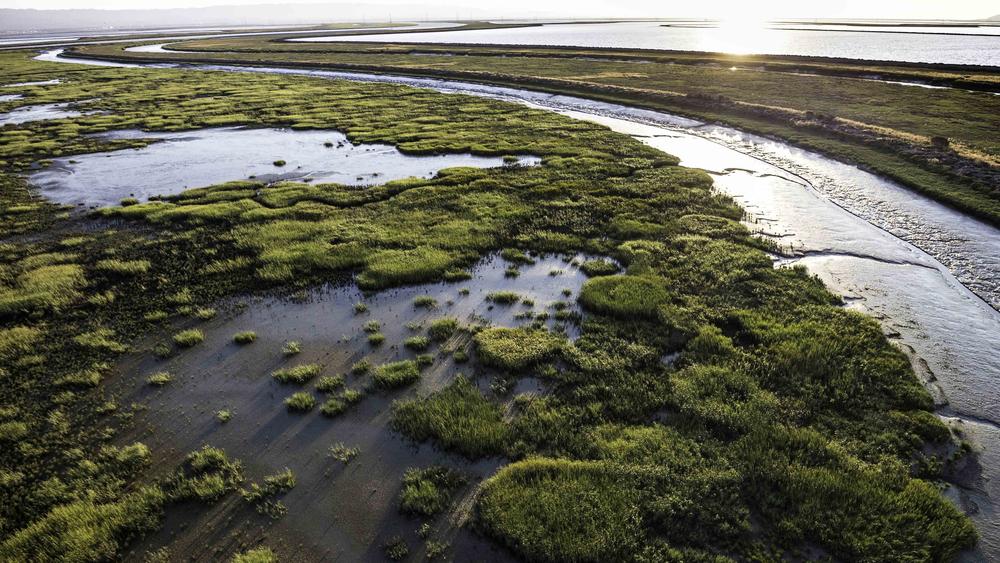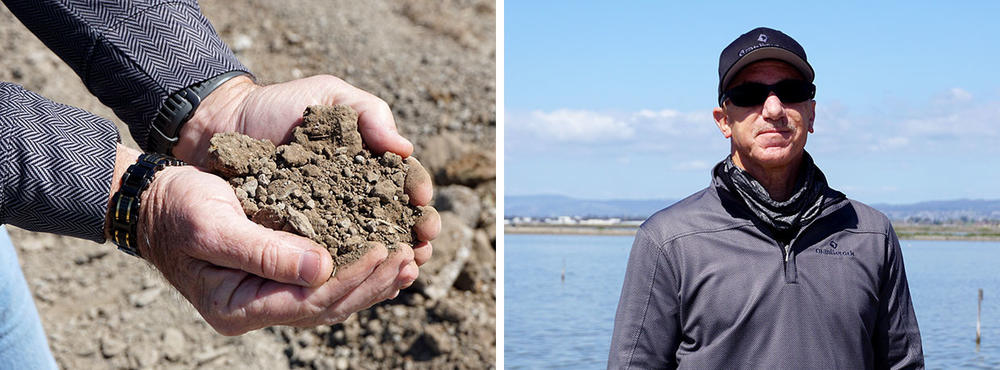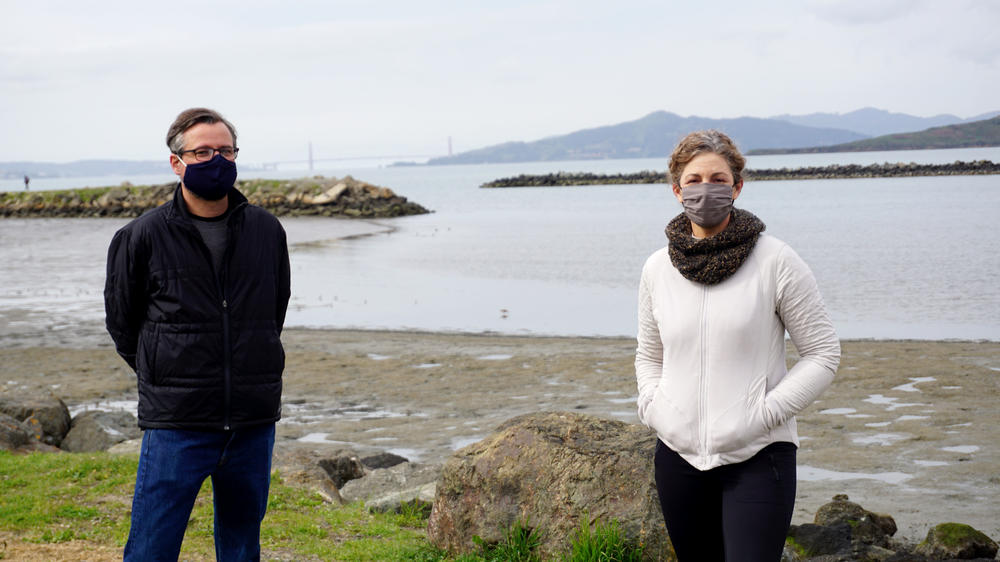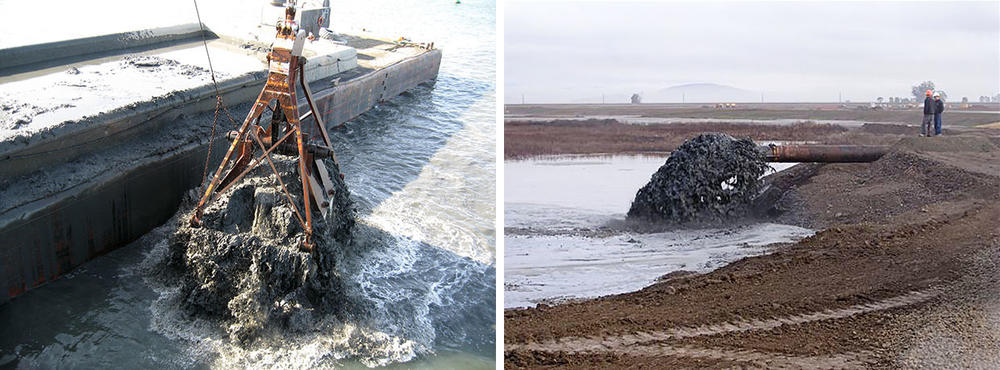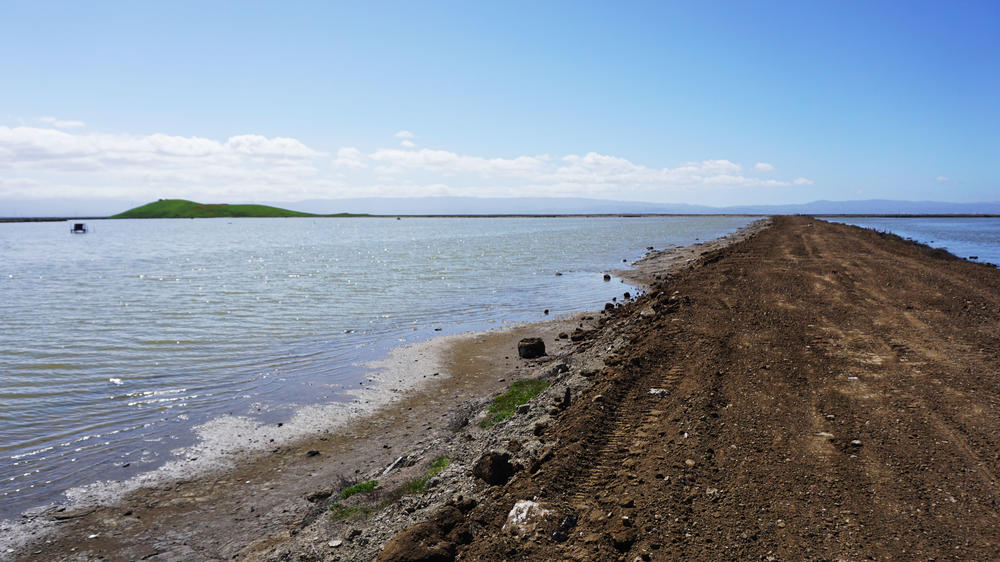Section Branding
Header Content
Got Mud? For Coastal Cities, Humble Dirt Has Become A Hot Commodity
Primary Content
In a hotter climate, dirt is a hot commodity.
With sea levels expected to rise three to six feet by the end of the century, coastal communities are moving fast to construct major shoreline projects to protect themselves. As the size of these projects expands, the primary building materials--dirt and mud --are getting scarce.
Dirt (what you dig up on land) and mud or sediment (the wetter variety already in rivers and bays) are the raw materials of climate change adaptation. They're used to build levees, the massive earthen barriers that hold back waves, and to raise elevation so buildings can sit higher than the floodplain.
Mud is also a crucial component of restoring wetlands and marshes, which act as natural barriers against storm surges while providing valuable habitat for sensitive species. In the right conditions, marshes can gain elevation over time from sediment, potentially keeping pace with sea level rise in a way that human-built infrastructure can't.
Until now, mud and dirt have mostly been treated as waste products. Dirt leftover from construction projects is often just trucked to landfills. Sediment is trapped behind large dams, no longer spreading naturally throughout watersheds.
Sediment is also dredged from shipping channels every year, but little is reused to adapt to climate change. The U.S. Army Corps of Engineers runs dredging operations, but its disposal policies mean that around 140 million cubic yards of sediment are dumped annually, even as restoration projects clamor for material.
Environmental experts warn that unless coastal regions from San Francisco Bay to the Mississippi River Delta begin managing their dirt and mud supply more comprehensively, the shortfall will be severe, leading to more expensive sea level rise protection and drowned wetlands.
"We're on the precipice of a huge crisis," says Letitia Grenier, senior scientist at the San Francisco Estuary Institute, a water and ecology think tank. "If we act now, we actually have enough sediment from other sources to keep our wetlands and to keep protecting our shorelines. But if we keep doing business-as-usual approaches, we're going to be in really big trouble."
Call the dirt broker
In a warming climate, there's a job in high demand that comes with an unglamorous name: "dirt broker."
"I hate that name," says Pat Mapelli, land use manager and bay restoration lead at Graniterock, a construction materials company. "I'll be honest with you. Dirt just has that negative connotation."
Mapelli is a highly sought-after terrestrial matchmaker. He brokers deals between those who need dirt and those who want to get rid of it. These days, his phone is ringing more often with requests he can't fulfill.
"The demand is way beyond what the supply is," he says, walking on an earthen levee on the eastern side of San Francisco Bay, a project he's putting together.
This part of the bay was once used for industrial salt making, and giant evaporation ponds were built here more than a century ago. Now, its marsh habitat is being restored as part of the Eden Landing Ecological Reserve. The old salt pond levees still stand between the bay and hundreds of thousands of people on the shoreline. But waves and weather have eaten away at them.
"It's very much lower than it should be right now and very much narrower than it should be right now," Mapelli says, looking at a stretch of levee bordering the blue, flat water of the bay.
Over the next several years, one million cubic yards of dirt will be brought to this site to build up the levees — the equivalent of 100,000 dump truck loads. Most comes from local construction projects doing excavation for foundations or underground parking garages.
Still, not all dirt is good dirt. Some of it contains pollutants or naturally occurring metals. Other loads are too far away, making the cost of trucking prohibitive. And often, construction companies want the fastest and cheapest solution, which means taking dirt to a landfill.
Mapelli knows the market for his services will only get stronger as more cities grapple with the fact that their shoreline infrastructure is being quickly overwhelmed by climate change. But the supply crunch has already hit.
"You're starting to look at all the edges around the bay and there's a lot of these projects," he says. "But it takes material. It takes dirt."
Sediment deficit
By some estimates, the shores of San Francisco Bay were once ringed by 200,000 acres of tidal marsh, a zone of low-lying plants inundated twice a day. The vast majority were filled in and developed as the population grew. Today, more than 90 percent of marshes in San Francisco Bay are gone.
The small pockets that remain, nestled between freeways and Costcos, are a magnet for wildlife, like scores of birds that make their annual migrations on the Pacific flyway.
"They're going to go off to the Arctic and make their babies, but right now this is where they need to feed and get fat so they can make that trip," Grenier says, looking out at flocks of Dunlin and Western Sandpiper scouring an exposed mudflat in Richmond, California.
Marshes also have a hidden talent, beyond providing habitat. They're a buffer against the bay itself.
"These marshes are knocking down the waves," Grenier says. "They're absorbing the water and they're really helping create flood risk management along the shore which is really critical for many billions of dollars of infrastructure as well as neighborhoods and other communities along the shoreline."
The San Francisco Bay region is gradually working towards restoring 100,000 acres of the historic marshes, through initiatives like the South Bay Salt Pond Restoration Project. But restoration isn't simple. Many former marshes have sunk over the years, their mud scoured away with no plants to protect it.
Often, the areas are too deep for tidal plants to grow again. So to restore them, huge amounts of mud is needed to raise the elevation. After that, the marshes are able to sustain themselves. With every tide that comes in, the water carries new sediment that is trapped by plants, replenishing the marsh up over time.
That's how, millimeter by millimeter, marshes and wetlands survive being worn away by waves. But soon, those waves will get a lot higher.
Rising sea levels threaten to drown wetlands by inundating and overtaking them. To keep up, marshes will require more sediment naturally floating in the water so they can build elevation to match.
Centuries of human intervention have starved almost every major watershed in the country of sediment. Enormous dams, built to store water in rivers upstream, are essentially sediment entrapment devices. Most have a growing pile of mud sitting behind their concrete wall, the collective evidence of what used to flow downstream to bays and estuaries. Nowhere is the problem more acute than on the Mississippi River, where dams reaching all the way to South Dakota are trapping sediment that once fed the wetlands of Louisiana.
All together, it adds up to a massive "sediment deficit."
"The demand for mud has increased astronomically because of sea level rise," Grenier says. "Because of this change that people have created, suddenly the natural world can't supply that much mud."
Grenier and her colleagues estimate that by 2100, 548 million metric tons of sediment will be needed to both restore wetlands and keep pace with sea level rise in San Francisco Bay. The natural supply will fall far short of that, bringing in about one-third to one-half of what's needed.
But there are options for filling that gap.
"It is not hopeless," says Scott Dusterhoff, senior scientist and lead geomorphologist at the San Francisco Estuary Institute. "We have a big problem on the horizon but if we look at all the sources of dirt and sediment that we have in the region that we can bring into play, we think we can meet it. We just have to change the way we manage sediment to get there."
Stuck on the least cost
Every year, hundreds of container ships sail under the Golden Gate Bridge, heading for the Port of Oakland via a shipping channel that's 50 feet deep. The depth of this channel and 10 others in the bay is maintained through regular dredging, by the Army Corps of Engineers.
Large dredging ships remove more than 2 million cubic yards of sediment per year in San Francisco Bay. Around two-thirds of it is disposed of, taken to approved sites to be released underwater. One is far outside the bay in the Pacific Ocean, 50 nautical miles from the Golden Gate.
For decades, the Army Corps has fielded requests to use this material for wetland and habitat restoration. But the agency says it's held to its "federal standard," a rule that stipulates the most affordable option for disposal be chosen.
Taking the mud to a restoration project sometimes means transporting it farther, adding cost to the trip, as well as requiring careful offloading to place it in the right spot. Releasing it at a disposal site underwater is generally cheaper.
The rule has limited the amount of sediment that's been reused, frustrating local and state officials.
"We're just going to be seeing erosion of our shorelines and mudflats and marshes unless we start doing things differently with sediment," says Amy Hutzel, deputy executive officer at California's Coast Conservancy, a state agency that works on restoration projects.
To complete several major marsh restoration projects around the bay, California has had to find ways to work around the cost standard. Many other states have, too. In a few instances, the Army Corps paid the extra cost of moving the sediment farther, but only after a specific act of Congress authorized the project, a time-consuming process. In other cases, California has paid the full additional cost itself.
"It's expensive," Hutzel says. "We can't sustain that cost. It's in the federal interest, and the feds should be cost sharing part of it."
The long term savings of avoiding flood damage from rising seas could dramatically outweigh the immediate cost of moving mud. Local and state officials say they've argued this point for years, but have seen little progress.
"The urgency is huge," says Hutzel. "It is frustrating that this has been decades of trying to solve this problem. And while there have been successes, we haven't fundamentally changed what's happening with dredged sediment in San Francisco Bay."
A new standard
The Army Corps of Engineers policy might change soon.
Last year, Congress passed the Water Resources Development Act of 2020, which included language directing the Army Corps of Engineers to "maximize" reuse and consider "economic and environmental benefits" in its cost analysis.
That language hasn't changed things on the ground yet, and the agency is writing specific guidance on implementation. .
"I think dredge material should be viewed as a really valuable commodity in that regard," says Tessa Beach, chief of the environmental branch of the Army Corps of Engineers San Francisco District. "We currently don't have implementation guidance on how the agency is going to carry out this direction, but this may lead to a different way of calculating the overall cost-benefit of different placement locations in the future."
The agency is currently gathering public feedback on the issue and says it can't comment on what the guidance will say. They expect to release it by August.
Depending on the result, the effects could be felt across the country, where billions of dollars are already being spent on restoring marshes and barrier islands from Poplar Island in Chesapeake Bay to Whiskey Island in Louisiana.
Still, environmental experts warn, it will take more than a select number of restoration projects to prepare for rising seas. The Army Corps of Engineers may need to fundamentally change its approach to sediment, releasing it in locations where it can mix into the water and naturally feed surrounding wetlands and marshes. That may be their only chance to keep pace with rising seas.
Copyright 2021 NPR. To see more, visit https://www.npr.org.
